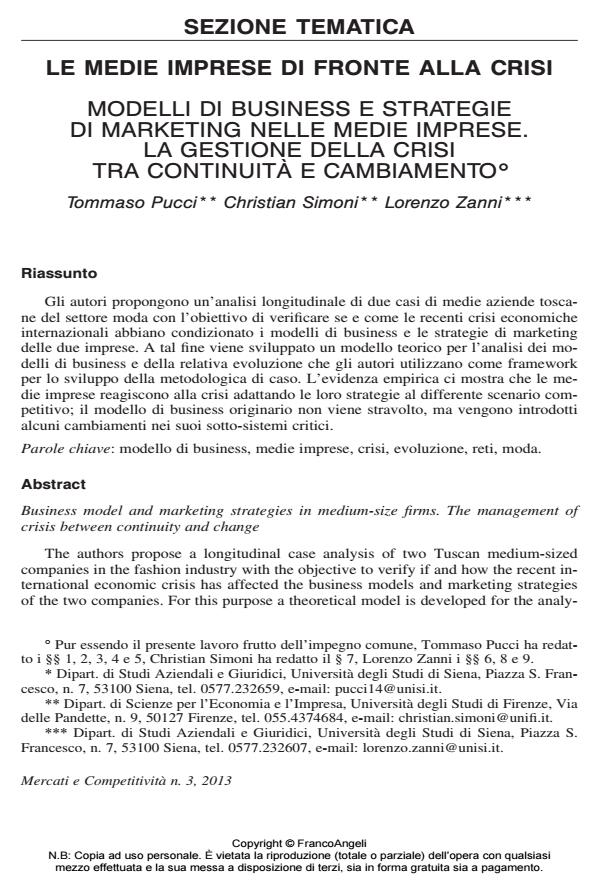Business model and marketing strategies in medium-size firms. The management of crisis between continuity and change
Journal title MERCATI E COMPETITIVITÀ
Author/s Tommaso Pucci, Christian Simoni, Lorenzo Zanni
Publishing Year 2013 Issue 2013/3
Language Italian Pages 21 P. 25-45 File size 789 KB
DOI 10.3280/MC2013-003003
DOI is like a bar code for intellectual property: to have more infomation
click here
Below, you can see the article first page
If you want to buy this article in PDF format, you can do it, following the instructions to buy download credits

FrancoAngeli is member of Publishers International Linking Association, Inc (PILA), a not-for-profit association which run the CrossRef service enabling links to and from online scholarly content.
The authors propose a longitudinal case analysis of two Tuscan medium-sized companies in the fashion industry with the objective to verify if and how the recent international economic crisis has affected the business models and marketing strategies of the two companies. For this purpose a theoretical model is developed for the analy- sis of business models and the relative evolution that the authors use as a framework to design the case study method. The empirical results show that medium-sized firms react to the crisis by adapting their strategies to a different competitive scenario; the original business model remains the same, but some changes in its critical sub-systems have been introduced.
Keywords: Business model, medium enterprises, crisis, evolution, networks, fashion.
- Mercati reali vs mercati virtuali? Uscire dalla crisi ripensando gli spazi della relazione con il consumatore Monica Calcagno, Francesco Casarin, in MERCATI E COMPETITIVITÀ 3/2014 pp.13
DOI: 10.3280/MC2014-003002 - Dibattito su esr XXXII (2) 2014. "le sfide dell'internalizzazione nel nuovo millennio" in ECONOMIA E SOCIETÀ REGIONALE 3/2015 pp.158
DOI: 10.3280/ES2014-003015 - La questione dimensionale per le imprese italiane nello scenario competitivo globale Fabio Musso, in ECONOMIA E SOCIETÀ REGIONALE 3/2015 pp.159
DOI: 10.3280/ES2014-003016
Tommaso Pucci, Christian Simoni, Lorenzo Zanni, Modelli di business e strategie di marketing nelle medie imprese. La gestione della crisi tra continuità e cambiamento in "MERCATI E COMPETITIVITÀ" 3/2013, pp 25-45, DOI: 10.3280/MC2013-003003